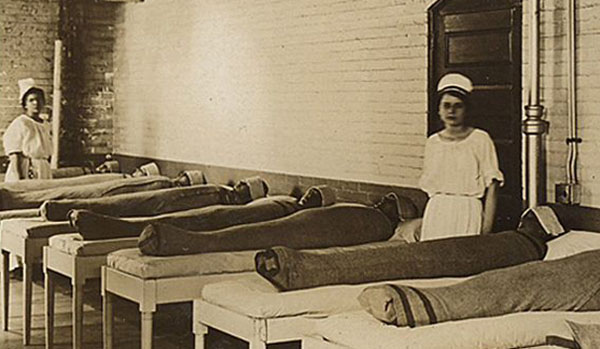A look at the historic use of strange psychiatric practices including dousing, gyrating, bleeding, and psychosurgery.
For years before the development of psychiatric drugs, the mentally ill posed a significant problem to the medical community. How could a doctor deal with a person who was immobilized by depression, violent with mania, or in the grip of terrifying hallucinations and delusions? Some doctors turned to extreme measures to gain control of the disturbing symptoms.
Most of the doctors who used these treatments were not sadists. They actually had reputations for being mental health advocates. They were using the best methods they knew to bring relief to the patient and his or her family. Still, it’s impossible to read this litany without shuddering.
Dousing Therapy – Drowning as a Psychiatric Treatment
Dousing therapy was initiated by Flemish physician Dr. Jan Baptista van Helmont. It made its way to the United States during the 19th century where it was sometimes practiced in asylums. Dousing therapy involved placing a restrained individual into a tank of water until, in the words of one observer, “bubbles of air ceased to rise.” The patient was then removed from the water and, with luck, revived.
The theory behind dousing was that someone who had come so close to death would get a fresh start, free from the psychiatric symptoms that had troubled him or her. Amazingly, the patients that survived the treatment did appear to benefit from it.
Status: The risk of drowning outweighed any potential benefits. The treatment is no longer in use.
Bleeding and Purging Calm the Savage Beast
During the 18th and 19th centuries, cutting a patient’s vein to allow significant loss of blood or giving medicines to induce vomiting or diarrhea were common medical practices. Psychiatrists used them to relax agitated patients.
The treatments were indeed calming–patients suffering from severe loss of blood or dehydration rarely had the strength to be combative.
Status: The practices of bleeding and purging were abandoned as doctors gained greater understanding of the mechanisms of disease.
Spinning or Gyrating to Relieve Mental Health Symptoms
Benjamin Rush, an advocate for humane treatment of the insane, had some odd ideas about curing mental illness. He routinely had patients placed in harnesses suspended from the ceiling. Attendants then swung and spun the patients for hours on end. Rush’s goals included reducing blood flow to the brain, relaxing the muscles, and lowering the heart rate.
Status: Perhaps some patients did find being swung and spun soothing, but the treatment never gained popular acceptance.
Electroconvulsive Therapy as a Psychiatric Treatment
Electroconvulsive therapy, also called electroshock or ECT, was developed by Italian Dr. Ugo Cerletti in 1938.
Shock treatment in the United States was used to treat many forms of mental illness. During its early days, massive shocks were administered to conscious patients. The resulting seizures were so strong that some patients suffered muscle damage or broken bones.
Status: ECT is effective at relieving the symptoms of intractable depression or mania. It remains in limited use. Patients today are anesthetized and given muscle relaxants before receiving a much milder shock.
Insulin Coma Therapy to Treat Mental Illness
Like ECT, insulin coma therapy was introduced to the United States from Europe in the 1930s. It involved giving psychiatric patients massive doses of insulin to send them into a hypoglycemic coma. The coma was then reversed with the administration of glucose. The psychiatric symptoms of the awakened patients were generally much improved initially, though patients tended to relapse after a few months.
Mathematician and Nobel Prize Winner John Nash received insulin coma therapy in 1961 to treat his paranoid schizophrenia. His results were typical–a rapid improvement of symptoms followed by a slow relapse.
Status: The medical community came to consider insulin coma therapy too risky–between one and ten percent of patients subjected to it died. It is no longer practiced in the United States, though it is still rumored to be in use in some parts of China and the former Soviet Union.
Psychosurgery – Deliberately Damaging the Brain
The earliest form of psychosurgery was known as trepanning, and it was practiced as early as 10,000 BC. It involved drilling a hole in the skull to release brain matter. Scientists believe this procedure was sometimes used on the mentally ill. Trepanning remained popular into the 18th century.
In 1935, Dr. Egas Moniz developed the frontal lobotomy. The typical lobotomized patient was calm, detached, and easy to care for, although some patients did become violent.
In the 1950’s, Dr. Walter Freeman refined Dr. Moniz’s procedure so it could be performed without general anesthesia and without the need for a surgical suite. His ice pick lobotomies were practiced in mental institutions throughout the 1950’s.
Status: Lobotomies fell out of favor with the advent of psychoactive medications that could treat the same symptoms without the permanent brain damage. Their use has not been outlawed in the United States, but they are rarely, if ever, performed.
Today’s Treatments – Psychiatric Medications
Today the treatment of most psychiatric conditions calls for the use of one or more medications. These medications are often used in conjunction with talk therapy or self help groups. Most people with even severe forms of mental illness are able to live and function in the community.
Psychiatric medications, however, are not without their critics. Some say psych meds are just another form of abusive psychiatric mind control, a non-surgical way to render difficult patients passive.
It would be interesting to take a peek into the future after the treatment of mental illness has evolved another hundred years or so. What will the people then think of the methods used to treat mental illness today? Will they admire the sophistication or shake their heads at the primitive bumbling?
Sources:
- Cinemania. “It Was a Brilliant Cure But We’ve Lost the Patient.”
- PBS Home Programs. A Brilliant Madness. Primary Sources: Insulin Coma Therapy.








